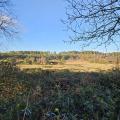"A Perfect Panorama of Beauty" - In the Frosty Footsteps of Flora Thompson (Second Attempt)
41 people attending
4 places left
“...A perfect panorama of beauty. Forestmere Lake lies like a mirror in the woods directly beneath; to the south is the blue ridge of the South Downs; to the north the heathery heights of Hindhead.” (Flora Thompson: Guide to Liphook, Bramshott and Neighbourhood, 1925.)
Or in the soggy footsteps of Flora Thompson, more like, given the time of year. Flora Jane Thompson (1876-1947) was an English novelist and poet best known for her semi-autobiographical trilogy about a Victorian childhood in the Cotswolds, Lark Rise to Candleford. In 1916 she moved to Liphook with her husband, and in 1926 they bought a house, Woolmer Gate, which we'll see, next to the pub in which we'll have our first pub lunch of 2025. The cosiness of the pub and its pleasing setting on a green will engender New Year good cheer, while the views we'll enjoy, as Flora enthused, will inspire us. This is a rescheduling of a walk that was due to take place when Storm Darragh struck.
The sights:
Weavers Down: Flora Thompson called Weavers Down 'Peverel Down'. In her Guide to Liphook, Bramshott and Neighbourhood of of 1925 she wrote that Peverel Down was the quote above, and that she was also intrigued by the trackways over it, writing: “... some of them still in occasional use, but most of them overgrown and deserted.” She imagined them in The Peverel Papers of 1922, “...winding in and out to skirt the hills and the marshes, just as they were first trodden by the naked feet of primitive man.”
Longmoor Camp: Wikipedia reports that this "is a British Army camp...The main street of the Longmoor part of the camp is built on an ancient Roman road, the Chichester to Silchester Way....The combined camp and training area covers 1,783 hectares (4,410 acres) of wooded areas, heaths, wetlands and hard standings. Longmoor Camp and the training areas are still active, and maintained by the Defence Infrastructure Organisation. The shooting and tank ranges are generally open to the public.
Longmoor Military Railway: Wikipedia reports that this was "built by the Royal Engineers from 1903 to train soldiers on railway construction and operations. The vehicles and stock...were very much an assortment to give the maximum learning opportunity. Well over a thousand locomotives had associations with the railway, although many only through the need for storage. The same was true of the signalling at the various locations on the line...After the end of World War II, the collection also included captured enemy equipment...The railway ceased operation on 31 October 1969". The railway was used as the location many films, including The Lady Vanishes (1938), Bhowani Junction (1956), The Inn of the Sixth Happiness (1958), Runaway Railway (1965), The Great St Trinian's Train Robbery (1966), The Magnificent Two (1967) and Chitty Chitty Bang Bang (1968). We'll follow much of the route of the railway back to Liss.
The route (please click on the link to see it at the Ordnance Survey website)
Dogs:
I welcome dogs on all my walks and this walk is highly suitable for them. It has no fields with livestock, and is of moderate length. There will also be some roads to cross and walk along. There are no stiles. A dog must be obedient if it is off the lead.
IMPORTANT! – Participation Statement:
You MUST complete a Participation Statement, in addition to booking your event space before attending an OutdoorLads event. You only need to complete this Participation Statement once, not for each event you attend.
(All pictures were taken by the leader in January 2025.)
















What to bring
Walking boots with thick socks will be essential to cope with the climbing. Wear clothing appropriate to the weather including warm kit in case of cold weather and waterproof kit in case of rain. Much of the walk will be on tarmac lanes and gravel tracks, but some woodland paths will inevitably be muddy.
Food & drink
We are booked in at the The Deer's Hut pub at 13.30 to have lunch. I will contact you two weeks before the walk to ask for your food order. Please reply promptly to this as it takes a long time to organise the pre-order. If you're unsure about coming on the walk, please still tell me your order, even if you might cancel (at no cost to either of us).
Alternatively, you're welcome to bring a packed lunch which you can have near the pub. Please tell me this too.
The menu
FARMHOUSE SANDWICHES £12.50: All served on pumpkin and sunflower seeded wholemeal brown bread (G.F* bread available) and served with skinny fries and mini salad bowl.
- British streaky bacon, brie and cranberry
- Festive feast: roast British turkey, stuffing and cranberry
- Mozzarella cheese, tomato chutney and basil pesto (V)
WRAP £12.50 (served with skinny fries and mini salad bowl): Tandoori free-range chicken, mango chutney, gem lettuce, tomato
MELT £14.00 (served with skinny fries and mini salad bowl): Tuna (MSC certified), spring onion and mature cheddar melt on ciabatta
STARTERS (TO HAVE AS A LIGHT MAIN)
- Home baked selection of breads and marinated olives £7.50 (V): tomato and basil butter
- Harissa and butterbean hummus £8 (Vegan) (D.F) (G.F): roasted beetroot, pistachios, pomegranate and flatbreads
- Chipotle barbecue crispy pork tacos £8: tomato and pineapple salsa, lime and coriander mayonnaise
- Freshwater Crayfish salad £10 (G.F): avocado puree, pickled cucumber, fennel and lemon crème fraiche
- Chicken liver parfait with sour cherry gel £8: Hampshire watercress, Palmer’s ale-soaked prunes and toasted brioche
- Homemade soup of the day £7 (G.F.*): sourdough bread and butter
TO SHARE: Baked camembert £17 (V) whole baked camembert infused with garlic and rosemary, caramelised red onion jam, and homemade toasted garlic breads (G.F.*)
HOMEMADE BURGERS (served with skinny fries) £17
- British beef burger £17: streaky bacon, smoked cheddar, tomato, lettuce, gherkins, with side of burger relish and
- Cajun buttermilk chicken burger £17: gem lettuce, tomato, chipotle mayonnaise on the side
- Halloumi burger (V) £16.50: field mushroom, gem lettuce, tomato, gherkins and chipotle mayo on the side
MAINS
- Dorset crab, spring onion and white wine butter linguine £22: topped with a spicy kick of chilli pangrattato
- Trio of Gloucester Old Spot free range pork sausages £18 (G.F): made by Morgan’s of Petersfield and served with bubble and squeak and onion gravy
- Confit of Gressingham duck leg £20 (G.F): Dauphinoise potato, braised red cabbage and port jus
- Sweet potato and spinach Dhal (Vegan) (G.F) (D.F) £18: basmati rice, poppadom, red onion and coriander salad
- Winter pumpkin risotto (V) (G.F) £17: sage and pecan pesto, vegetarian Parmesan and Hampshire watercress
- Pan-fried fillet of Cornish Hake (G.F) £22: fondant potato, parsnip puree, samphire and herb oil
- Palmer’s beer battered large Fish and Chips (D.F.) £20: mushy peas, tartare sauce and wedge of lemon (Fish certified by the Marine Stewardship Council)
- Homemade pie of the day (please refer to the specials board) £20: served with creamy mash potato and seasonal vegetables
- Honey roast thick cut Hampshire ham (G.F.) £16.50: two fried free-range eggs, chunky chips and garden peas
- Fillet steak: Morgan’s of Petersfield best Scottish Angus X 8oz (G.F) £35: served with thick cut chips or skinny fries, field mushroom, plum tomato, and Hampshire watercress. Add peppercorn sauce £3 (G.F.) (tell me if you want this sauce)